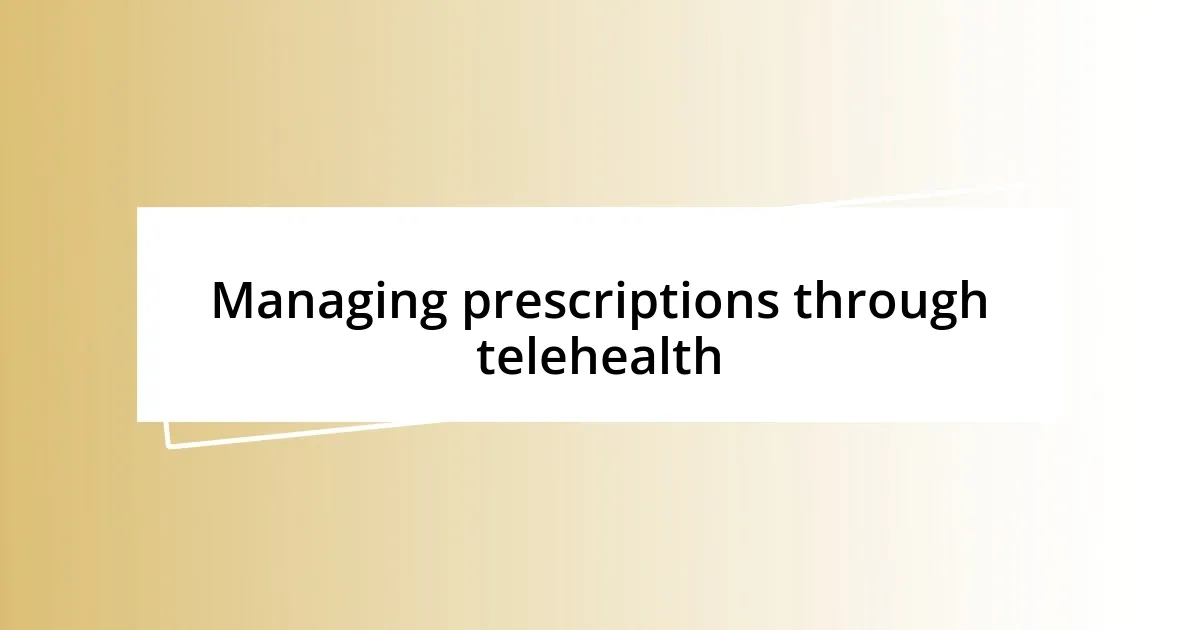Key takeaways:
- Telehealth prescriptions enhance healthcare accessibility, especially for patients in remote areas, allowing for timely medication management without extensive travel.
- Key benefits of telehealth include increased convenience, time efficiency, better chronic condition management, and lower overall costs for patients.
- Technology tools like video conferencing, electronic health records, and mobile health applications improve the telehealth experience by facilitating real-time communication and personalized care.
- Challenges include technology barriers for older adults, inadequate patient information access, and communication gaps during consultations, emphasizing the need for user-friendly systems and effective provider engagement.

Understanding telehealth prescriptions
When I first encountered telehealth prescriptions, I was surprised by how convenient they were. Imagine sitting on your couch, connecting with a doctor in seconds, and having a prescription sent straight to your pharmacy. It felt like something out of a science fiction movie, yet here we are, living in a time where healthcare can be just a click away.
One significant aspect I’d like to highlight is how telehealth prescriptions can bridge accessibility gaps, especially for those in remote areas. I remember speaking with a friend who lived in a rural town, far away from any medical facility. She shared how telehealth transformed her healthcare experience, allowing her to receive timely medications without the stress of long travel. It made me think—how many lives could be positively impacted by this innovation?
Another thing that often comes to mind is the way telehealth prescriptions empower patients. The process usually requires you to actively engage with your healthcare provider, asking questions and voicing concerns from the comfort of your home. This was eye-opening for me; I realized that these virtual interactions can help build a stronger patient-provider relationship. It’s intriguing, isn’t it? I often wonder how this shift in communication will shape the future of healthcare.

Benefits of telehealth for patients
One of the most remarkable benefits I’ve noticed with telehealth is the time saved for patients. Often, I’ve found myself spending hours in waiting rooms, feeling that precious time slip away. With telehealth, I can schedule appointments that fit my life, reducing the hassle of long commutes and wait times. It’s liberating to know that I can meet with a provider and get prescriptions in the same breath as I prepare dinner in my kitchen.
Here are a few notable advantages of telehealth for patients:
- Increased Accessibility: Patients in rural or underserved areas can easily connect with specialists.
- Convenience: Seeing a doctor can happen from anywhere, whether it’s your home or while traveling.
- Time Efficiency: Shorter appointment times mean less time away from daily activities or work.
- Better Management of Chronic Conditions: Regular check-ins via telehealth can lead to improved health outcomes.
- Lower Costs: Reduced travel expenses and time off work can lead to overall savings for patients.
I remember a time when I had to manage my asthma and chase after a doctor for a refill. With telehealth, I can simply have a quick chat, and just like that, my prescription is on the way. This ease not only alleviates my worries but also fuels a more proactive approach to my health—something I don’t take for granted anymore.

Technology tools for telehealth services
When it comes to telehealth services, the technology tools at our disposal are pretty fascinating. I’ve learned that video conferencing platforms like Zoom and Doxy.me have become essential for connecting patients and providers. These tools not only allow real-time discussions but also enable a level of personalization that enhances the healthcare experience. The first time I used such a platform, I felt a sense of relief, being able to see and hear my doctor instead of just talking over the phone. It made the interaction feel more human, and it reinforced the trust I had in my provider.
Another crucial aspect of telehealth technology is the integration of electronic health records (EHR) with prescribing software. This seamless connection allows providers to access vital patient information swiftly and accurately, ensuring prescriptions reflect current medical conditions. I remember one instance where a doctor quickly adjusted my medication dosage after reviewing lab results on her screen during our virtual visit. That level of efficiency reinforced my confidence in telehealth services and demonstrated how intertwined technology and patient care can be.
Moreover, mobile health applications are transforming how we approach our health management. I’ve personally used apps that remind me to take medication or track my symptoms, significantly easing my anxiety about managing chronic conditions. When I first downloaded one of these apps, it felt empowering. Knowing that I had a tool guiding me through my health journey gave me a sense of control I often lacked before. The blend of technology and personalized care in telehealth not only opens doors but also fosters an environment where I feel supported every step of the way.
| Technology Tool | Functionality |
|---|---|
| Video Conferencing (e.g., Zoom) | Facilitates real-time consultations between patients and providers. |
| Electronic Health Records (EHR) | Stores and organizes patient information for seamless access and prescription management. |
| Mobile Health Applications | Helps patients manage their health with reminders and tracking features. |

Managing prescriptions through telehealth
Managing prescriptions through telehealth has been a game-changer for me. I recall a particularly hectic week where I was juggling work and family obligations. Instead of feeling the stress of trying to squeeze in a visit to my doctor, I simply logged onto my telehealth platform. Within minutes, I was chatting with my physician about my current medication, and by the end of the appointment, a new prescription was sent to my pharmacy. It felt like a weight lifted off my shoulders.
Sometimes, I think about how easy it is to overlook the small things, like prescription management. I’ve had moments when I forgot to refill my medication and found myself in a panic. With telehealth, those worries are significantly reduced. I can set reminders or even discuss preventive measures with my provider during my virtual visits, ensuring that I always have what I need when I need it. Isn’t it comforting to know that your health can be managed with just a few clicks?
Moreover, the streamlined communication I experience with telehealth helps me stay on top of my prescriptions. I remember a time when my doctor adjusted my dosage during a video call. Learning about that change in real-time felt so reassuring. It made me realize how crucial it is to have immediate access to healthcare advice. In this fast-paced world, having my prescriptions managed through telehealth not only saves time but also provides me with peace of mind. How many times have you wished for that kind of efficiency in managing your healthcare?

Challenges faced in telehealth prescriptions
One of the biggest challenges I’ve encountered with telehealth prescriptions is the initial technology barrier, especially for older adults. I remember helping my grandmother navigate her first virtual appointment; she was frustrated and confused by the interface. This experience made me realize how crucial it is to offer user-friendly platforms and adequate tech support. If people struggle to access care, they might miss out on essential prescriptions.
Another issue that often surfaces is the lack of comprehensive patient information. I had a telehealth appointment where the doctor couldn’t see my previous medical history due to a system glitch. As someone who values continuity in care, this left me feeling uneasy. It’s essential that healthcare systems find ways to ensure that patient data is always up-to-date and accessible. Otherwise, you risk compromising the quality of care.
Moreover, I’ve noticed that communication can sometimes falter in telehealth settings. There have been moments when I felt like I wasn’t fully heard during consultations, leading to misunderstandings about my prescriptions. Don’t you agree that effective communication is the backbone of healthcare? Providers need to actively engage and confirm understanding to make sure patients feel supported. After all, health management should be a collaborative effort, even when it’s happening through a screen.














